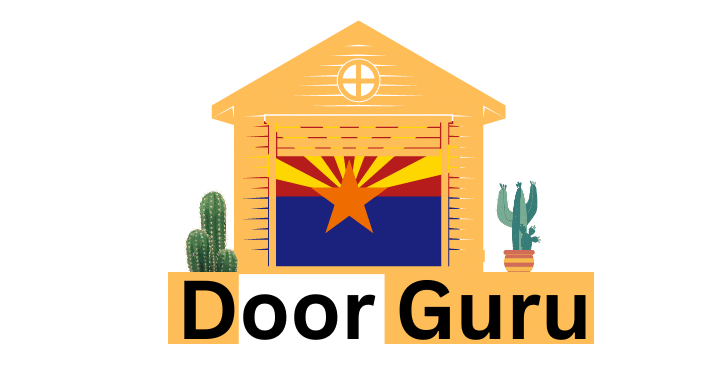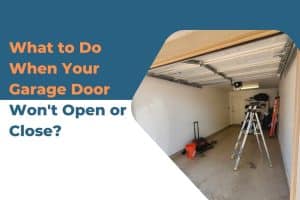Is there anything more frustrating than a garage door that refuses to open or close when you need it to? We’ve all been there – rushing to leave for work or coming home after a long day, only to find your garage door stuck in place. If you’re experiencing this issue in Peoria, AZ, don’t worry. In this comprehensive guide, we’ll walk you through the steps to troubleshoot and address the most common reasons why your garage door might not open or close as it should.
When your garage door face difficulty opening or closing in Peoria, AZ, it may stem from various underlying causes. Here are potential reasons and corresponding solutions:
- Power Source Examination: Your garage door opener relies on a power source. If it’s not receiving power, it won’t function correctly. To address this:
- Verify the working status of the power outlet.
- Ensure the power cord is firmly plugged in.
- Remote Control Inspection: A malfunctioning remote control could be the culprit. For resolution:
- Replace the remote-control batteries.
- Attempt reprogramming the remote if battery replacement doesn’t resolve the issue.
- Safety Sensor Check: Safety sensors situated at the base of the garage door track can lead to problems if they are misaligned or obstructed. To rectify this:
- Inspect the sensors for cleanliness and proper alignment.
- Track Inspection: Over time, the tracks guiding the garage door’s movement can accumulate dirt or become misaligned. Address this by:
- Cleaning the tracks using a cloth.
- Ensuring the tracks are correctly aligned.
- Moving Parts Lubrication: To guarantee smooth operation, apply a silicone-based lubricant to all the moving components of your garage door. This will enhance its performance and longevity.
By following these steps, you can often diagnose and resolve the issues causing your garage door to malfunction in Peoria, Arizona.
Understanding the Basics
Before we dive into the troubleshooting process, it’s essential to have a basic understanding of how your garage door system works. A typical garage door operates with several key components:
- Garage Door Opener: This motorized device is responsible for lifting and lowering the door.
- Springs: Torsion or extension springs counterbalance the weight of the door, making it easier to open and close.
- Tracks: The tracks guide the door’s movement and keep it aligned.
- Remote Control: This device allows you to open and close the door from a distance.
Common Reasons for Garage Door Problems
There can be various reasons why your garage door isn’t functioning correctly. It’s crucial to identify the cause before attempting any fixes. Here are some common issues:
1. Sensor Obstruction
Garage doors have safety sensors near the base on either side. These sensors prevent the door from closing if they detect an obstacle in the way. Check for obstructions such as debris, toys, or even spider webs. Clean the sensors and ensure they are aligned properly.
2. Power Issues
Your garage door opener relies on electricity. If there’s a power outage or a tripped circuit breaker, your door won’t function. Check your home’s electrical panel and reset the breaker if necessary.
3. Damaged Springs
Torsion or extension springs can break or wear out over time. If you notice a broken spring, it’s essential to contact a professional for repair. Attempting to replace springs yourself can be dangerous.
4. Remote Control Problems
If your remote control is not working, try replacing the batteries. Ensure that the remote is within range and pointed at the receiver on the garage door opener.
5. Track Misalignment
Tracks that are bent or misaligned can prevent your garage door from moving smoothly. Inspect the tracks for any issues and adjust them if needed.
Troubleshooting Steps
Now that you have a better understanding of possible issues let’s go through the troubleshooting steps:
1. Check for Sensor Obstruction
- Inspect both sensors to ensure they are clean and free of obstructions.
- If they are misaligned, gently adjust them until they face each other.
- Test the door to see if it closes properly.
2. Verify Power Supply
- Check the power supply to the garage door opener. Ensure the power cord is plugged in and that there is electricity.
- If there’s a power outage, wait for it to be restored.
- If it’s a tripped circuit breaker, reset it.
3. Inspect Springs
- Examine the springs for any visible damage. If you see a broken spring, do not attempt to repair it yourself. Contact a professional.
- Springs should be replaced in pairs if necessary.
4. Test the Remote Control
- Replace the remote control’s batteries with fresh ones.
- Check the range by standing closer to the door.
- Ensure nothing is blocking the signal between the remote and the garage door opener.
5. Examine Tracks
- Visually inspect the tracks for any dents, bends, or misalignments.
- If you notice any issues, carefully adjust the tracks to align them properly.
- Lubricate the tracks to ensure smooth door movement.
When to Call a Professional
While these troubleshooting steps can help you address some common garage door issues, there are situations where it’s best to call a professional technician:
- If you’re not comfortable with the repair process.
- If the problem is related to complex electrical or mechanical components.
- When dealing with a broken spring, which can be dangerous to replace without the right tools and knowledge.
Garage door professionals in Peoria, AZ, are experienced in handling a wide range of issues and can provide you with a safe and efficient solution.
Regular Maintenance to Prevent Future Problems
Preventing garage door issues is often as simple as regular maintenance. Here are some tips to keep your garage door running smoothly:
- Lubricate Moving Parts: Regularly lubricate the rollers, tracks, and hinges with a silicone-based lubricant to reduce friction.
- Tighten Hardware: Check and tighten all the nuts and bolts on the door and track system. Loose hardware can cause misalignments.
- Test Balance: Disconnect the door from the opener and manually lift it. It should stay open halfway. If not, it might be off-balance and needs adjustment.
- Replace Weatherstripping: Damaged weatherstripping can allow drafts and moisture into your garage. Replace it when needed.
- Clean the Tracks: Keep the tracks clean from dirt and debris to ensure the door moves smoothly.
Conclusion
Dealing with a garage door that won’t open or close can be a stressful situation. However, by understanding the common reasons behind such problems and following the appropriate troubleshooting steps, you can often resolve the issue yourself. Remember to prioritize safety and call in a professional when necessary to ensure the safety and functionality of your garage door in Peoria, Arizona. By following these guidelines, you can keep your garage door running smoothly and avoid unexpected inconveniences.


